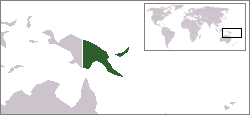
Back Territoriu de Papúa y Nueva Guinea AST Тэрыторыя Папуа і Новая Гвінея Byelorussian مەڵبەندی پاپوا گینێی نوێ CKB Territorium Papua und Neuguinea German Territorio de Papúa y Nueva Guinea Spanish Papuan ja Uuden-Guinean territorio Finnish Territoire de Papouasie et Nouvelle-Guinée French Teritori Papua dan Nugini ID Territorio di Papua e Nuova Guinea Italian パプア及びニューギニア準州 Japanese
Administrative Union of the Territory of Papua and the Territory of New Guinea | |||||||||||||
|---|---|---|---|---|---|---|---|---|---|---|---|---|---|
| 1949–1975 | |||||||||||||
| Anthem: God Save the Queen (1952–1975) O Arise, All You Sons (1975)[1] | |||||||||||||
 | |||||||||||||
| Status | United Nations Trust Territory (New Guinea) External territory of Australia (Papua) | ||||||||||||
| Capital | Port Moresby | ||||||||||||
| Common languages | English (official) Austronesian languages Papuan languages English creoles German creoles | ||||||||||||
| Demonym(s) | Papua New Guineans, Papuans | ||||||||||||
| Monarch | |||||||||||||
• 1949–1952 | George VI | ||||||||||||
• 1952–1975 | Elizabeth II | ||||||||||||
| Administrator | |||||||||||||
• 1949–1952 (first) | Jack Keith Murray | ||||||||||||
• 1974–1975 (last) | Tom Critchley | ||||||||||||
| Chief Minister | |||||||||||||
• 1972–1975 (last) | Michael Somare | ||||||||||||
| Legislature | Legislative Council (1949–1963) House of Assembly (1963–1975) | ||||||||||||
| History | |||||||||||||
| 1 July 1949 | |||||||||||||
• Self-governing | 1 December 1973 | ||||||||||||
| 16 September 1975 | |||||||||||||
| Currency |
| ||||||||||||
| |||||||||||||
| History of Papua New Guinea |
|---|
 |
|
|
The Territory of Papua (British New Guinea) and New Guinea (German New Guinea), officially the Administrative Union of the Territory of Papua and the Territory of New Guinea, was established by an administrative union between the Australian-administered territories of Papua and New Guinea (the latter being a United Nations trust territory administered by Australia) in 1949. In December 1971, the name of the Territory changed to "Papua New Guinea" and in 1975 it became the Independent State of Papua New Guinea.[2]
Though the two different Territories merged on the 16th September 1975, the nationality of the people of Papua remained as Australian Citizens and the people of New Guinea remained as United Nation's Protected Persons.

